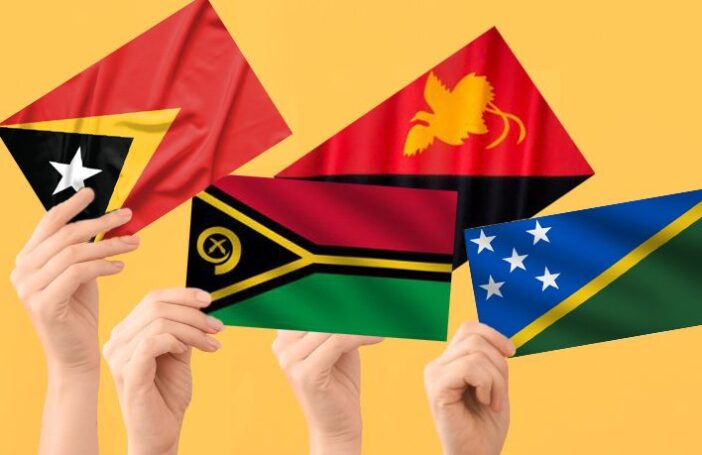Information on the number of registrations for the ballot for Australia’s new Pacific Engagement Visa has been released. 56,127 people across the Pacific applied for the visa by registering for the ballot.
Demand for the PEV was highest in Fiji, where there were 102 ballot registrations — or primary applicants — for every visa (Figure 1). Tonga took second place, with 37 primary applicants for each visa, and Timor-Leste was in third spot with 23 per visa.

PEV primary applicants could also register family members in the ballot. I assume that on average primary applicants registered 1.5 unique family members for the visa. (This is no more than what seems like a reasonable guess. Data on this has not been made available.) On this assumption, 20% of Tuvalu’s population applied for the PEV, 13% of Tonga’s, and 8% of Nauru’s and Fiji’s (Figure 2).

New Zealand has long had its own PEV equivalent. In the three countries in which both visas are available, Australia’s PEV seems to have been more popular (Figure 3). For example, in Fiji, in 2019 (the last year for which I have been able to find the NZ data), there were 75 total applications for the NZ visa, compared to 254 for this visa (including the assumed number of family members).

For all countries, the estimated ratio of visas to all applicants was 1.9% for Australia’s PEV, compared to 2.7% for New Zealand’s equivalent. We had predicted that the popularity of the PEV would grow over time to eventually match the popularity of New Zealand’s PEV, not that it would match or even exceed the popularity of the NZ visa in its first year.
It was unclear how many applicants there would be for the PEV in Papua New Guinea given the difficulties in getting a passport there (primary applicants needed a passport to enter the ballot) and the lack of a migration tradition, but in the end there were six primary applicants in PNG for each visa, or perhaps 15 applicants per visa in total. When the PEV was first announced, it was said that country quotas would be proportional to population. If so, PNG would have been allocated 2,200 visas, many more than the 1,350 it was actually allocated. The popularity of the visa in PNG suggests that PNG’s allocation should be increased.
Likewise, the strong demand for the PEV in Solomon Islands, Timor-Leste and Vanuatu suggests that these countries should also have their visa quotas increased. These countries, like PNG, have been historically disadvantaged by not having access to Australia via New Zealand. Now that we know there is demand for the visa in these countries, their quota should be increased. Other quotas do not need to be reduced. Rather, the aggregate 3,000 visa total could be increased.
There were only two countries where the PEV ballot was unsuccessful. In the Federated States of Micronesia and Palau, despite a two-week extension, there were fewer than 10 primary applicants for the 50 visas on offer in each. Both countries already have unrestricted access to the US labour market (though not to US citizenship), and I had advised against including them in the PEV. It is embarrassing that we could not even give away offers of permanent migration in these two countries, and they should be excluded from next year’s ballot.
While successful applicants have already been informed of their good luck, it is possible that a few more applicants will be chosen. Only 2,700 visas (out of the 3,000 total) were allocated to the 10 participating countries, with 300 reserved for Samoa and Kiribati. With those two countries (inexplicably) to date declining to take part in the PEV, and undersubscription in FSM and Palau, there could be some 350 visas additional visas available this year for those countries with excess demand. I hope these visas will be utilised.
Overall, despite the FSM/Palau fiasco, the first PEV ballot was an overwhelming success in terms of the numbers applying.





I have a question and that is how is the PEV ballot being processed; as in are people still being approved? is the department going through each application to consider people to apply?
Is there any information on the gender of the applicants? I just wrote a gender analysis on this visa for an ANU class…! Interested to know if there was a gendered bias.
No information, sorry. I agree it would be interesting.
Why is there an unfair distribution of PEV visa, given Fiji’s significant presence in overseas employment? Fijian workers are known for their hard work, resilience, and excellence, even in unskilled visa categories. With the high demand for overseas opportunities from Fiji, why is Papua New Guinea being offered more placements?
Hi Emele, I do not speak for those distributing the places but you have already answered your own question there: there are already more Fijians in Australia than people from any other Pacific country, and part of the motivation here was to expand opportunities to those with historically less access. Of course, PNG also has ten times the population of Fiji. I don’t disagree with anything your have said about Fijian workers though, and agree that there should be a large increase in places for Fiji (and all participating countries) next year.
So the 300 visas reserved for Samoa and Kiribati plus the unused visas for Palau 50-9= 41, FSM 50-8=42, (300+41+42= 383) visas will be distributed among the high PEV demanding countries like Fiji, Tonga, TL, SI, Tuvalu, Vanuatu, and PNG for the second ballot selection?
I hope so. That would make sense, but it has not yet been announced. Note for Palau and FSM some primary applicants would have applied with family, so the number of spare visas will be less than 41 and 42, respectively.